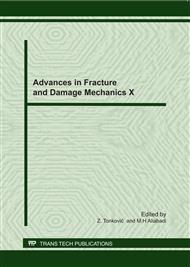p.507
p.511
p.521
p.525
p.529
p.533
p.537
p.541
p.545
Developed Random Tessellation for Modeling of Microstructure
Abstract:
The concept of random tessellation is extensively used in wide area of natural sciences, especially material sciences. In this paper a simple but complete explanation of the random tessellation and mathematical tools requirements is presented. Then introducing the algorithm and the program for display random tessellation diagram was written. This program, with high speed and simple algorithm for random tessellation has the ability to change the level of statistical parameters such as number, mean, variance of the area of the grain. The ability to model microstructures of metals and grains for mechanical application, such as estimation of mechanical properties and crack propagation model in microstructure scale is very important. Finally, the microstructure produced by this program show good fitness of random generation with real microstructure.
Info:
Periodical:
Pages:
529-532
Citation:
Online since:
September 2011
Authors:
Keywords:
Price:
Сopyright:
© 2012 Trans Tech Publications Ltd. All Rights Reserved
Share:
Citation:


